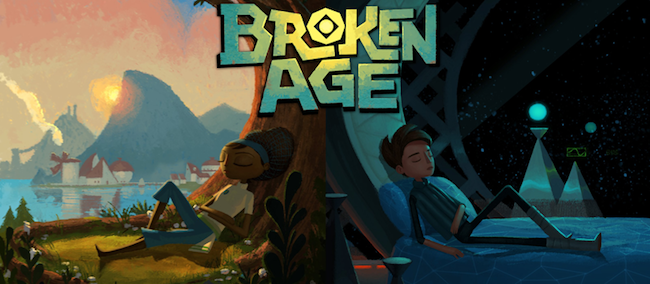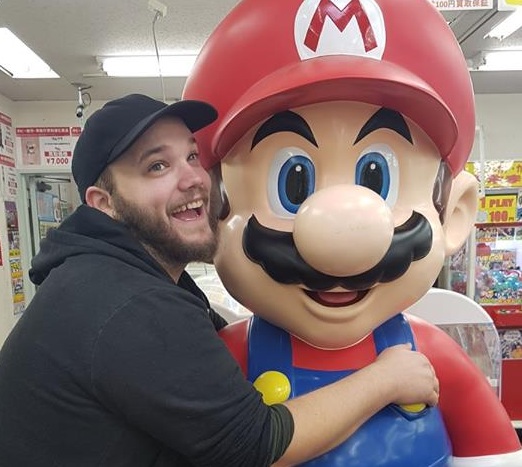
For many gamers, Broken Age is simply the resurfacing of a title that was made famous when it created a tornado of money through Kickstarter, and showed us all the potential of crowd funding. However, for me, it was the pay-off for a small monetary investment and a couple of years of waiting. My minor involvement in the project as a kickstartee, a starter of kicks if you will, didn’t guarantee my approval. If you’ve read my post-kickstarter release review of the OUYA, or even just spoken to someone who was unfortunate enough to buy an OUYA, you’ll know that I’ve been burned before. Instead, Double Fine’s “Broken Age” won me over in the few weeks I had to spend with the game and enjoy the fruits of what happens when developers actually listen to what their players want.
Broken Age answered the unasked question: “What’s better than a single, well rounded story?” The answer, as developers Double Fine discovered, is two well rounded, seemingly unrelated stories which entwine together unexpectedly (sorta) at the end of the game. It all begins with our two protagonists lounging in their respective environments, and the game allowing the player to choose which one to start with: A girl who is unsure of her lot in life as the village offering to a terrifying monster, and a boy who whiles his days away, trapped in a spaceship designed for someone far younger than himself with no discernible purpose. As a premise, Broken Age feels unique in its choice of setting and characters; both of which will charm the pants off of you before the credits roll.

Conveyance in a videogame’s narrative is important because it makes or breaks a player’s ability to immerse themselves in the games world, and Broken Age has it in spades. Through environmental cues, character dialogue, and good old fashioned story progression, BA: Part 1 does a good job of providing an understanding of the different worlds that the game takes place in without talking down to you or outright hand feeding you the necessary information. It’s an important aspect of point-and-click adventure games, and Broken Age absolutely nails it; allowing you to adjust to the separate story lines before convincingly combining them at the end (though you may or may not see it coming, depending on how much attention you were paying up to that point.)
Being able to freely switch between the two characters removes the usual pacing restrictions of story progression. You can break up both characters’ stories into segments of your own length and choosing, or flick between the two of them when you feel stuck and need to change up your perspective. The differences between Shay and Vella, from their worlds to their personalities, are a stark contrast, and it keeps things from becoming boring by not repeating the same tasks in both stories. Broken Age’s narrative, with a little suspension of disbelief, is near-flawless. Even the most jaded of gamers should find a slice of joy in this modern return to a classic genre.

The game stirred calcified and atrophied parts of my brain that hadn’t been used in quite some time, abandoning any notion of holding your hand through each puzzle. It won’t simply throw you into the deep end with absolutely no explanation of how the game mechanics work, which are simple and effective, but it isn’t afraid to assume that its players will have the wherewithal to figure out the puzzles on their own. To create the puzzles items can and usually do interact with one another in unexpected ways, and the answers are in true point-and-click style, indirectly given to you in dialogue hints leading up to the puzzle so that the game (and anyone watching you play) can snidely laugh at you while you frustratedly try to combine a spoon with every other object in the game.
The games best features, however, are double-edged, and there are moments where certain design decisions can work against it. The world available for exploration is usually physically small, meaning you won’t have far to go when the puzzles stump you but also means that it doesn’t have the same kind of “expansiveness” that the games spiritual fore-runners had. The environments are greatly detailed and lovingly illustrated, breathing a unique life into each area, however, there’s usually very little in these environments that you can interact with for more dialogue or possible puzzle solutions. This doesn’t really inhibit the game in any way, but it seems like something they could have, and probably should have, improved on to help flesh out the exploration aspect of the game.

Gameplay in a point and click adventure game is all in the name of the genre, and there’s plenty of pointing and clicking to go around in Broken Age. The game runs smoothly, and despite some reported experiences of events not triggering correctly, or items not working as they should, I remained capable of executing ridiculous solutions to silly puzzles without interruption. Though, being an early-access game for some, it’s not unreasonable to assume that there may have been a few bugs in the lead up to full release. The only other interactive part of the game is dialogue, and Double Fine have provided it in hilarious abundance. I hated Wesley Crusher, almost as much as The Big Bang Theory. And yet, I enjoyed Wheaton’s character; which speaks for the quality of the script!
If ever there existed a candidate for “videogames as art”, in my opinion, it’s Broken Age! The artwork, music, and voice acting blend together to create a sense of charm which is laced throughout the game, the importance of which can’t be understated in a genre that’s all about staring at the same scenery for what can feel like an age (ha!). It hasn’t forgotten its roots either, and as such, includes a hidden easter-egg feature that enables a pixelated view of the games graphics, resembling games such as Monkey Island or Loom. This “retro” appearance still looks pretty amazing, if only for the nostalgic feeling that it brings to the game, and it shows that the developers had those old titles well in mind while creating what is essentially a homage to an all but forgotten genre and style.

For a genre which has been on the brink of death for many years, receiving only the occasional and savage attempts at revival until Telltale came along and “jazzed things up” with The Walking Dead, there’s little, in my opinion, that can be found to fault with Broken Age. Double Fine set out with the single goal of creating a classic adventure game for the players, and even with a few flaws, which do nothing to diminish game so far; their design has seen that goal through to an admirable accomplishment. Broken Age is like a DIY classic car restoration project: There is still visible rust on the surface that needs to be scraped off, it’s compiled of many recycled parts, and it isn’t quite the way you remember it from way back when. However, it’s a job well done nonetheless.
Broken Age is a great return to the adventure games of yore, and proves to some degree that the genre is far from dead. At this point in time, the experience has only been positive for me so far. However, while I’m looking forward to seeing everything it has to offer in its entirety, it’s too early to call whether or not the game as a whole will live up to expectations. The game is in two parts, and the final verdict can only come after they’ve both been released. However, if what I’ve played so far is any indication, then it could easily become one of the best in 2014!











